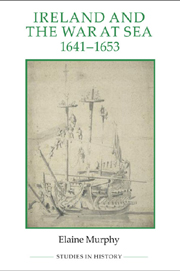Book contents
- Frontmatter
- Contents
- List of figures, maps and tables
- Acknowledgements
- Abbreviations
- Glossary
- Map 1 Ireland, 1641–9: principal ports and locations
- Map 2 The British Isles, 1641–9: principal ports and locations
- Map 3 The British Isles and Europe, 1641–9: principal ports and locations
- Introduction
- PART I The War at Sea, 1651–1653
- 1 The outbreak and spread of the rebellion, October 1641–September 1643
- 2 ‘Weathering the storm’, September 1643–July 1646
- 3 ‘Infested with pirates’, August 1646–August 1649
- 4 The support of the navy, September 1649–April 1653
- Part II Navies and the Conduct of the War at Sea
- Appendices
- Bibliography
- General index
- Index of ships
1 - The outbreak and spread of the rebellion, October 1641–September 1643
from PART I - The War at Sea, 1651–1653
Published online by Cambridge University Press: 05 April 2013
- Frontmatter
- Contents
- List of figures, maps and tables
- Acknowledgements
- Abbreviations
- Glossary
- Map 1 Ireland, 1641–9: principal ports and locations
- Map 2 The British Isles, 1641–9: principal ports and locations
- Map 3 The British Isles and Europe, 1641–9: principal ports and locations
- Introduction
- PART I The War at Sea, 1651–1653
- 1 The outbreak and spread of the rebellion, October 1641–September 1643
- 2 ‘Weathering the storm’, September 1643–July 1646
- 3 ‘Infested with pirates’, August 1646–August 1649
- 4 The support of the navy, September 1649–April 1653
- Part II Navies and the Conduct of the War at Sea
- Appendices
- Bibliography
- General index
- Index of ships
Summary
‘The object was a sudden, bloodless coup leading to the immediate gaining of a military position sufficiently strong to make the effective intimidation of the English parliament possible.’
The leaders and planners of the 1641 rebellion did not envisage fighting a long war. Their plans for the rebellion did not therefore include any maritime dimension such as the seizure of key ports or coastal citadels. Instead they sought to capture the seat of English power in Ireland, Dublin Castle, and to seize a number of strategically important inland fortifications in Ulster. From this position of military strength they hoped to negotiate concessions from King Charles i and parliament. On the evening of 22 October 1641 the plot to seize Dublin came undone as one of the conspirators revealed its details. Government officials in the city arrested many of the plotters. At the same time, however, in the north of Ireland, rebel leaders, like Sir Phelim O'Neill, succeeded in taking a number of strongholds including Charlemont fort, Mountjoy Castle and Tanderagee, and over the following days and weeks the rising spread through Ulster and further south. By Christmas 1641 there were reports of rebel activity in most counties. The rebellion developed beyond the initial elite-led conspiracy into a war that affected the entire country and all sections of society. As the nature of the rising changed the naval dimension of the conflict and events at sea began to assume importance for the insurgents and the government in Ireland and London.
- Type
- Chapter
- Information
- Ireland and the War at Sea, 1641–1653 , pp. 13 - 34Publisher: Boydell & BrewerPrint publication year: 2012



